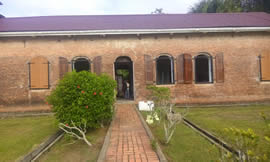"Renewable energy: Any energy resource that is naturally regenerated over a short time scale and derived directly from the sun (such as thermal, photochemical, and photoelectric), indirectly from the sun (such as wind, hydropower, and photosynthetic energy stored in biomass), or from other natural movements and mechanisms of the environment (such as geothermal and tidal energy). Renewable energy does not include energy resources derived from fossil fuels, waste products from fossil sources, or waste products from inorganic sources." - Texas Renewable Energy Industries Alliance
Hydropower (or hydroelectric power) refers to the use of energy from naturally falling or flowing water to generate electricity. The kinetic energy from the falling water is converted to mechanical energy and then to electricity.
Water constantly goes through a vast global cycle. It evaporates from lakes, rivers, oceans, and other bodies of water; forms clouds, precipitates as rain or snow, then flows back to the rivers, oceans, etc. The water cycle is, therefore, driven by the sun. In this cycle, water is not reduced or used up in the process; the water cycle is a constantly recharging system. That is why hydropower is considered a renewable energy source.
The Hydropower Plant
Conventional Hydropower plants have five major components:
- Dam, or Diversion and Intake Screen - This creates a reservoir to raise the water level of the body of water, controls the flow of water or directs it into a pipe or channel.
- Penstock (pipeline) - This carries the water to the turbine.
- Turbine - The kinetic energy from the falling water turns the turbine which converts the kinetic energy to mechanical energy.
- Generator - This is connected to the turbine by way of shaft and, often, gears. It converts the mechanical energy of turbine to electrical energy.
- Transmission and Distribution Network - This is used to carry electricity from the hydropower plant to consumers.
The amount of power a hydropower plant can generate depends on three main factors: (i) the vertical distance the water falls (referred as the 'head'); (ii) the amount of water flowing; and (iii) the efficiency of the system - i.e. how well the turbine and the generator can convert the energy from the falling water to electricity. Essentially, the higher the head, or the larger the flow of water (say, in cubic meters per second), the more power can be generated.
Hydropower Plant Types
Hydropower schemes can be placed into three categories:
1) RUN-OF-RIVER
This type of scheme has little or no storage (reservoir) even though it may carry a dam for the diversion or control of water flow. In this type of scheme, electricity production is based on the natural flow and elevation drop of the river. The timing of certain levels of generation is dependent on the river flow and cannot be scheduled.
2) RESERVOIR (STORAGE) SCHEME
With this type, water is stored behind a dam in a reservoir for use at times when water flow is lower than required, providing the capacity to schedule generation somewhat independent of the level of flow in the river.
3) PUMPED STORAGE SCHEME
Pumped storage plants are mainly storage systems to provide large-scale energy storage. This type of scheme uses electricity during off-peak periods to pump water from a lower reservoir or river to the higher reservoir so that the water can be used to generate electricity at peak times and provide system stability. The losses of the pumping process adds to the sorage cost, but this system of energy storage is generally more cost effective than using batteries.
Hydropower Scheme Classification
Below is a description of the typical classification (according to the International Renewable Energy Agency [IRENA]).
- Large-hydro - 100 MW or more
- Meduim-hydro - 20 MW to 100 MW
- Small-hydro - 1 MW to 20 MW
- Mini-hydro - 100 kW to 1 MW
- Micro-Hydro - 5 kW to 100 kW
- Pico-hydro - A few hundred Watts up to 5 KW
These classifications may change from country to country.
References:
- "Hydropower Basics," U.S. Office of Energy Efficiency and Renewable Energy, accessed July 10, 2015, http://energy.gov/eere/water/hydropower-basics.
- "Microhydro Power Basic," Home Power, accessed July 10, 2015, http://www.homepower.com/articles/microhydro-power/basics/what-microhydro-power.

